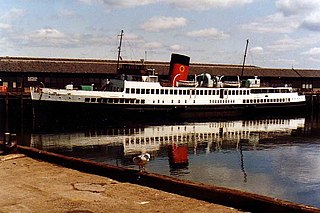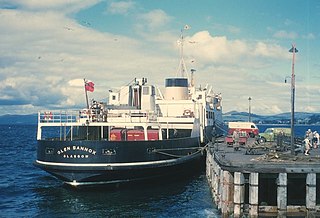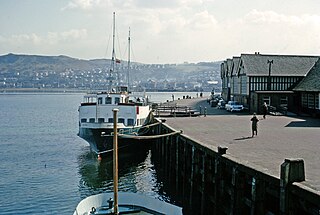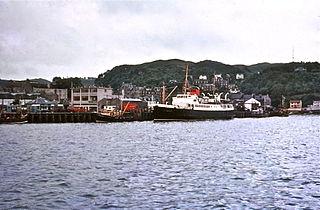Layout
King George V was novel in design, providing spacious accommodation with an enclosed promenade deck, the saloon extending the full width of the hull and half the length of the vessel. Above this was an observation deck. The restaurant was aft on the main deck, with large observation windows. [4]
Her machinery was even more innovative. Seven turbines, with two very high pressure boilers, were linked by gears to twin propellers. The boilers had to be replaced after tubes burst. A first incident happened off Irvine at the end of the 1927 season, when two firemen were killed. A second incident was in Kilbrannan Sound, with no loss of life. [4] She was re-boilered in 1929 and again 1935. In 1935, one turbine was removed to simplify the power system and two new, slightly broader funnels were fitted.
A main mast was fitted in 1952, radar in 1958 and in 1959, inflatable life rafts replaced two of her lifeboats. [3] She was further modernised in the winter refits of 1960 and 1961.
Service
King George V was initially mainly used on the Inveraray service but also visited Campbeltown. [2] She became a much loved ship. After 1935, she was based in Oban cruising round Mull, to Iona, Staffa and Fort William.
In World War II, she was requisitioned as a troop carrier, initially based at Southampton. In 1940, she evacuated troops from Rotterdam, Ostend, Calais, Boulogne and famously, Dunkirk, landing 4300 men at Dover. [2] Returning to the Clyde in 1941 for tendering duties, she carried Prime Minister, Winston Churchill to his battleship en route to the Atlantic Conference. [4]
After the war, she resumed MacBrayne cruises on the Clyde in 1946, including the summer Ardrishaig mail service. [2] She was back to Oban in 1947 and each summer until withdrawn in 1974. In her final years she also undertook charters, including one to Bangor in Ireland. [4]

TS Queen Mary is a Clyde steamer launched in 1933 at the William Denny shipyard, Dumbarton, for Williamson-Buchanan Steamers. She is currently being restored as a museum ship, in Glasgow.

The Clyde steamer is the collective term for several passenger services that existed on the River Clyde in Scotland, running from Glasgow downstream to Rothesay and other towns, a journey known as going doon the watter.

MV Pioneer is a stern / side loading ferry built in 1974, in service for 29 years covering nearly all of Caledonian MacBrayne's routes. She now serves the islands of São Tomé and Príncipe in the Gulf of Guinea and was chartered to rescue Liberian refugees.

MV Glen Sannox was a Clyde car ferry launched in 1957. Built for the Arran service, she spent her first 14 years there. Thereafter, she had a versatile career on the west coast of Scotland, lasting over 32 years, including providing cruises between 1977 and 1982. In 1989, she was sold for service on the Red Sea. She ran aground south of Jeddah and lay in a sunken condition from 2000.

TS King Edward was an excursion steamer built at Dumbarton for service down the River Clyde to the Firth of Clyde and associated sea lochs on the west coast of Scotland, as far as Campbeltown. The first commercial vessel to be driven by steam turbines, King Edward operated as a Clyde steamer for half a century from 1901 until 1951, interrupted only by service in the two world wars. The success of the vessel quickly led to the adoption of turbine propulsion for all manner of merchant vessels, from channel ferries and coastal steamers to transatlantic liners.

MV Juno was a passenger and vehicle ferry operated by Caledonian MacBrayne on the Firth of Clyde, Scotland between 1974 and 2007. She was the middle of three vessels nicknamed "streakers", the first in the Calmac fleet to be fitted with Voith Schneider Propellers. Juno left service in early 2007 and was laid up at Rosneath for 4 years. On 18 May 2011, she was beached there for scrapping and was gone by the end of July.

MV Maid of Argyll was a passenger ferry operated by Caledonian Steam Packet Company, initially based at Craigendoran. Rendered redundant by the car ferry revolution, she was sold to Greek owners in 1975. She caught fire in 1997 and was left to decay.
MV Maid of Skelmorlie was a passenger ferry operated by Caledonian Steam Packet Company from 1953. Rendered redundant by the car ferry revolution, she was sold to Italian owners in 1973. After conversion to stern-loading, she operated, as Ala in the Bay of Naples for 20 years.
MV Maid of Cumbrae was a British passenger ferry operated by Caledonian Steam Packet Company from 1953. In the face of the car ferry revolution, in 1972, she was converted to a 15-car ferry for the Dunoon to Gourock crossing. Sold to Italian owners in 1978, she operated, as Capri Express in the Bay of Naples until 2006, when she was scrapped.

MV Arran was a pioneering Firth of Clyde vehicle ferry introduced by Caledonian Steam Packet Company in 1953. She spent fifteen years on the Upper Clyde crossings, followed by five years at Islay. Initially hoist-loading, via side ramps, these were replaced by a stern ramp in 1973. During her final years with CalMac, she relieved across the network. Several unsuccessful attempts were made to turn her into a floating restaurant, before she was scrapped in 1993.

David MacBrayne is a limited company owned by the Scottish Government. Formed in 1851 as the private shipping company David Hutcheson & Co. with three partners, David Hutcheson, Alexander Hutcheson and David MacBrayne, it passed in 1878 to David MacBrayne.

MV Claymore (II) was David MacBrayne's last mail boat built in 1955. She served on the Inner Isles Mail on the west coast of Scotland until 1972. Subsequently sold for day cruising in the Greek Islands until 1993, she sank at her mooring in 2000.

PS Caledonia was a paddle steamer built in 1934. She principally provided an Upper Clyde ferry service, later moving to Ayr and then Craigendoran.

TS Duchess of Montrose was a Clyde passenger steamer, built in 1930 for the Caledonian Steam Packet Company. She was a popular boat, providing day cruises until 1964.
TS Duchess of Hamilton was a Clyde passenger excursion steamer, built in 1932 for the Caledonian Steam Packet Company. She was a popular boat, providing day cruises from Ayr and remaining in service until 1970.

RMS Columba was a Clyde paddle steamer, MacBrayne's flagship from 1879 to 1935. She ran the first leg of "The Royal Route" to Ardrishaig for fifty eight summers.

PS Iona was a MacBrayne paddle steamer, which operated on the Clyde for 72 years, the longest-serving Clyde steamer.
TS Queen Alexandra was a MacBrayne turbine steamer built in 1912 and operating cruises on the Clyde. Following extensive modifications, in 1935, as Saint Columba, she took over the "Royal Route" from Glasgow to Ardrishaig until scrapped in 1958.
MV Lochnevis was a MacBrayne mail steamer, built in 1934 for the West Highland service. She was withdrawn in 1969, sold to Dutch owners in 1970 and scrapped in 1974.
MV Lochfyne was a MacBrayne mail steamer, built in 1931 for the West Highland service, the first British coastal passenger ship with diesel-electric propulsion. After long service, she was withdrawn in 1969 and scrapped in 1974.

















